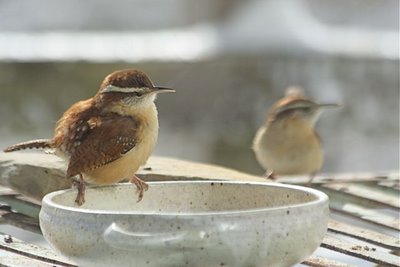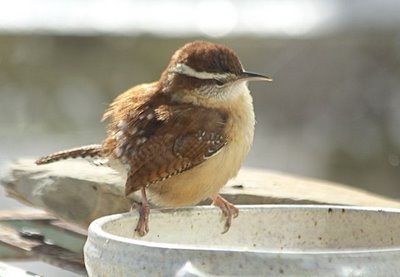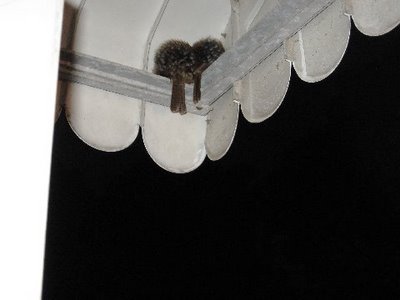About Those Wren Rump Spots
In my last post, I drew attention to the white spangles on the lower back feathers of a Carolina wren, and said I had a Science Chimp theory about them. Any time I see ornamentation on a bird that is hidden from sight when the bird is doing its normal daily routine, I wonder what's going on there. Is there a function to those spangles, one that isn't immediately apparent?
During the ice storm of 2009, the sun broke through only intermittently. This photo was taken on a sub-freezing day, when a wren who had come for some Zick Dough suddenly realized how glorious it felt to have sun on his (or her) back. The bird keeled over in a classic sunning pose, its rump feathers lifted and ruffled, as if trying to soak up maximum rays.
 Its mate seems to wonder what's come over it. Honey? You OK?
Its mate seems to wonder what's come over it. Honey? You OK?The wren held this pose for almost a minute, giving me a chance to zoom in on that lovely rump.

The lower back feathers need to be raised and fluffed to reveal the white spangles lying just beneath the brown outer feathers. It really is a lovely effect, but one we all too seldom see. I have seen it, though, on my own porch. At night.
If you saw this on your porch by the light of a flashlight, and you weren't reading a post about Carolina wren rump spangles, would you know what it was?

Neither did the person who sent the picture to my friend Sharon from Maine. Sharon is always getting asked questions about birds. She always knows the answer but likes to check in with the Science Chimp just for fun.
These are roosting Carolina wrens. Awwww. They almost always roost together; they stay as a mated pair year round, and are almost never out of earshot of each other.
My S.C. theory on the rump spangles is that they are meant for camouflage. I'm not sure what they make these sleeping wrens look like, but they don't look much like birds, do they? When I've seen wrens sleeping in the bucket up under my front porch eave, or tucked into a corner in the garage, my first thought is that I'm looking at some kind of small furry mammal. Pretty much the last thing they look like is a defenseless, sleeping bird.
It's not a fully-formed theory, obviously, and I'm open to alternate hypotheses. I just think it's cool to see a small bird utterly transform its shape and appearance while sleeping. And maybe someone out there will look up someday, see a spangly blackish blob up under the porch eave and smile, knowing what it is.
Labels: Carolina wrens, roosting Carolina wrens, rump spots on Carolina wrens, sunbathing in birds, wren camouflage





